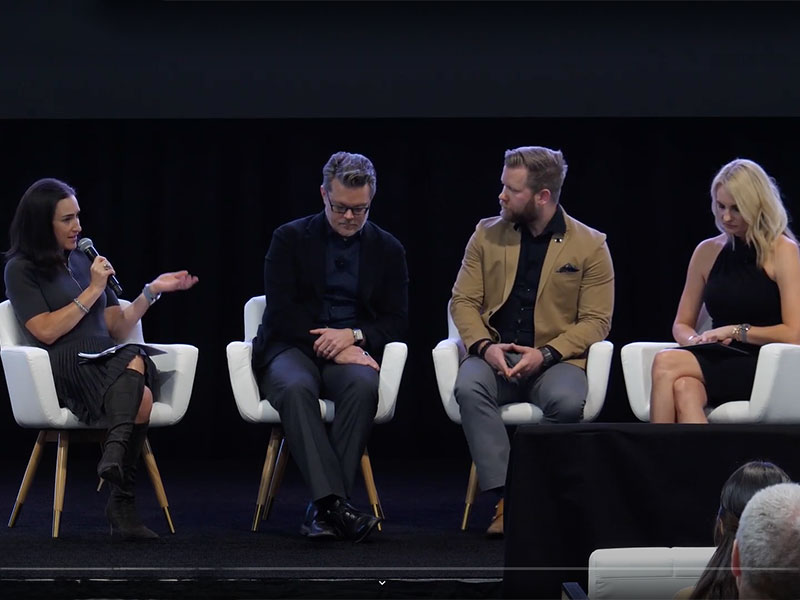
I had the privilege of joining other industry water experts at KBIS 2024 on KBIS NEXTStage. The topic of the session was “Drops of Impact: The Crucial Role Water Plays in Sustainable Futures.”
Per the KBIS conference website:
Water is a finite and essential resource, and its careful management is fundamental to sustainable home design. Sponsored by Moen and moderated by Sara Gutterman, CEO of Green Builder Media LLC, this panel will prove that sustainability and style can coexist harmoniously and demonstrate how new technology and innovations can help homeowners use water more responsibly. Featured speakers include Mark-Hans Richer, Moen; Christoph Lohr, IAPMO; and Ginger Rabe, Ginger Rabe Designs, LLC.
As I prepared for this panel discussion, I couldn’t help but smile over an early-career memory about design and functionality: As an early-career plumbing engineer, I was working on a residential kitchen project, and selected a very functional kitchen faucet. When I submitted my cutsheet to my client at the time, the designer of the kitchen came back with an email that said, “Can’t we find something a little … nicer looking? The one you picked is pretty ugly.” How humbling! This was a good lesson for me that even as an engineer, I needed to be mindful that form and function need to go together and that “nobody wants to use an ugly faucet.”
But we need to remember not to place form over function – especially as our water systems deal with many challenges. I was reminded of this as I have been reading the book The Profits of Distrust: Citizen-Consumers, Drinking Water, and the Crisis of Confidence in American Government by Manuel P. Teodoro, Samantha Zuhlke and David Switzer. In the book’s introduction, the authors ask a poignant question: “The burgeoning bottled water industry presents a paradox: why do people choose expensive, environmentally destructive bottled water, rather than cheaper, sustainable, and more rigorously regulated tap water?”
I would add not only that, but likely unhealthy water as micro-nano plastics seem to proliferate bottled water, with high storage temperatures of bottled water being a possible catalyst. Water quality is just one challenge though; sustainable water solutions are also important, as my home state of Arizona shows: new home developments in some parts of the Phoenix metro area are being halted due to a lack of sufficient groundwater. Kitchen designers can be part of the effort to develop kitchens that are more sustainable, with better water quality (i.e. safety), all while improving affordability: Or as we at IAPMO like to say, a plumbing resilient solution. Here are three ways kitchen and bath designers can make an impact on water use in homes.
Tip #1: Get the right filter for the right job: Provide solutions to customers that improve water quality at the kitchen tap while also positively impacting water sustainability.
One of the biggest hurdles to getting homeowners to drink from the tap is building trust that the water is safe to drink. The lowest-hanging fruit is to make sure water is aesthetically pleasing, especially making sure “floaters” in water are removed before ending up in a glass. Micron filters, especially 2-5 micron filters, are the tool of choice for this concern. Next up are the “unseen” contaminants, like carcinogenic disinfectant byproducts; PFAS, an emerging contaminant; or even pharmaceuticals, which a granular activated carbon (GAC) filter can remove.
For owners who want the highest level of filtration, the next choice is typically reverse-osmosis (RO) systems. RO systems in essence remove everything from the water, and can only connect to faucets via plastic piping.
However, whereas micron filters and carbon filters do not waste water, RO water can use up much more water: the typical system only produces 1 gallon of drinkable water (product water) while 9 gallons go straight to the drain (reject water). EPA WaterSense RO systems improve this slightly by having 3 gallons of product water and 7 gallons of reject water. Owners who want the highest level of filtration but also want to be water conscious utilize ASSE 1086 RO systems, which create 4 gallons of product water and only 6 gallons of reject water.
To make sure quality products are used, look for a third-party listing on devices put in the home for products that are listed to a standard:
| Client Concern | Solution |
| Want to prevent “floaters,” sediment, etc. in the glass. | >5 micron filter that complies with NSF 42 |
| Want to remove “unseen” contaminants from water. | Utilize a granular activated Carbon Filter that complies with NSF 42 and NSF 53. |
| Wants to have the highest quality of as possible while minimizing water waste. | Utilize a reverse osmosis (RO) system that complies with ASSE 1086 (which exceeds current EPA WaterSense efficiency). |
Getting the right filter for the right job has never been easier.
Tip #2: “Don’t cheng unless you chi.” Look to innovate industry apps to provide added value to clients without sacrificing performance.
In his book Certain to Win, Chet Richards says, “Think of what happens when you are deciding to buy … products and services … You expect them to work. This defines ‘cheng’ in their businesses, doing well what the customer expects, things like quality in term of “free from defects,” low price, good performance …” while “chi” is the “unexpected delight” that a customer receives that keeps them coming back for more.
When it comes to “cheng” and “chi” in homes, the expectations are high in shower performance. This makes sustainability a sticking point: nobody wants shampoo stuck in their hair for minutes on end. Therefore, finding ways to provide sustainability without sacrificing performance is key. Fortunately, “there is an app for that.” Actually, there are a few“applications” for that.
The first app is one that would need to take place before a home is built: make sure your builder is aware of IAPMO’s Water Demand Calculator® – a 21st century way to size the pipes in a home. This solution not only saves builders money by reducing pipe sizing, but also allows for potential water savings by reducing structural water waste (450 gallons per year per one study). By mentioning this tool before construction begins designers can bring “chi” to their business associates, further cementing valuable business networks. This application literally is an app that the builder can use during design!
Sometimes a designer may not get involved until later in the construction or may be involved in a remodel that doesn’t include plumbing renovation. In that case, there is an opportunity to reduce behavioral water waste by using another “physical application”: shower and tub spout flow restrictors that comply with IAPMO IGC 244. These devices reduce the flow to a shower (or tub spout) when the water reaches bathing temperatures. At that point the owner can pull a tab to re-engage full flow, thereby eliminating the water going down to the drain while the bather remains away from the shower after the desired bathing temperature water has been reached. Other “applications” to help water conservation efforts include leak detection devices that comply with ANSI/CANIAPMO Z1349 that may be able to provide household comparisons of water use through an app.
Tip #3: Be a water ambassador: Enlighten clients and business partners as they go through the design process, and be willing to think outside the box.
The one thing we can do right now is become more familiar with water stressors in our area, and become a water ambassador. Educating ourselves first by understanding our current challenges is vital. Bringing up water with clients and our business partners is the next step. Perhaps we are still some time away from gray water reuse systems in every new home as Seth Siegel describes in his book Let There Be Water: Israel’s Solution for a Water-Starved World, where bathing and clothes-wash water could be recycled and used to flush toilets. Being aware of solutions and spending time learning about water conservation technologies and opportunities is vital. In doing so you can balance performance and water conservation for your customers.

Christoph Lohr
Last modified: March 20, 2024
